Home seedlings based on industrial technology
The transition to small-volume cassette technologies is already a serious step forward. But technology is also a technology, it must be complex and complete. The capacity of the substrate in each individual cell is very small, in some cases, it is only 5-10 cubic centimeters, and our main task is to create an optimal microclimate for plants, that is, the temperature in the nursery, the humidity of the air, the humidity of the substrate must be constantly maintained at an optimal level. The most difficult issue is maintaining the moisture content of the substrate so that the roots are constantly in a comfortable and favorable state for the growth and development of seedlings. You can, of course, monitor and maintain the substrate moist by hand, but in this case, there are no guarantees that you will not accidentally forget to water it on time and will not dry the substrate along with the seedling roots. Therefore, I believe that the process needs to be automated. How to make a "technological hotbed" and how to entrust the care of plants to automation?
Let's start with the nursery.
The base of the nursery is a greenhouse, the sizes of which may vary. But it must be closed with a "cap" made of transparent material. For example, I decided to make a similar greenhouse using a thin molded polycarbonate hood. The size of this cap is 65x110 centimeters, it has a center height of 35 cm and ventilation holes. I took a piece of chipboard from an old cabinet, you can take, for example, thick plywood, made low sides, put a piece of film on this base so that the chipboard does not get wet and I ended up with a simple structure that can be placed anywhere: on a windowsill, on a table, on a rack in a greenhouse. But how to water the plants in such a structure? Manually? It is ineffective, inconvenient, and tender newly emerged plants can be damaged. Well, since I am a lazy person, it is natural for this design I picked up suitable mini sprinklers, mounted 2 such mini sprinklers on the base and installed the automation. Let's see how it all looks in the photo?

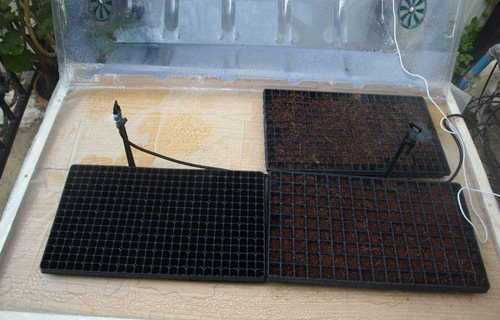
We install sprinklers and check how they work.


Two options for installing sprinklers and automation. Search for the best option.

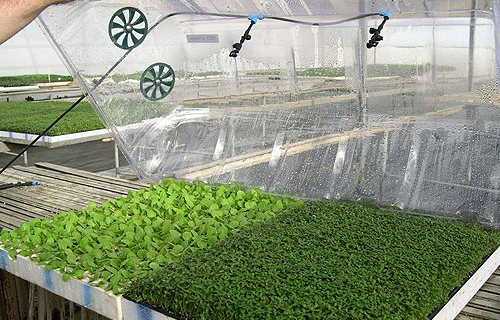
And what can you grow in this mini greenhouse?
The creation of such a "superstructure" took me about 3.5 hours. In the "Technological nursery", 4 standard seedling cassettes fit. How many plants will turn out - count yourself?
I would like to note that the filter and the automation unit can be used both for one and for several similar installations. It's just that all subsequent installations are connected to the automation unit in parallel using one single pipe for water supply.
And instead of polycarbonate, you can of course use a simple film on a wireframe. This is for talented homemade people with crazy hands.
Details and subtleties
In such a limited space as a seedling greenhouse, it is quite difficult to water the seedlings. I had to test several different models of mini sprinklers, as a result, 4 models turned out to be the most suitable: 4191, 809, 806S and 4463 Since all these models can be easily replaced, then those who are going to build such device, I would like to recommend having as replaceable - all these models. How do they work? Let's take a look at the photo.


This is how models 4191 and 809 work
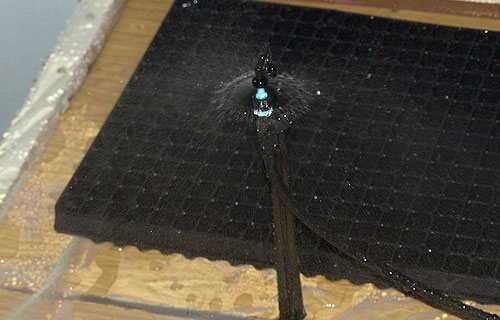
This is 806S
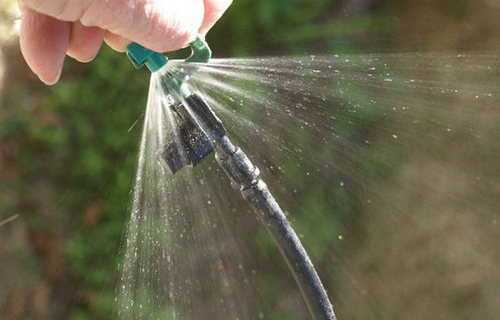
4463 works here
With a range of interchangeable sprinklers, it is easy to select the desired spray pattern and spray pattern.
Automation and stuff.
Well, they sort of figured out the sprinklers. But how to ensure the required irrigation rate? It's really hard to do without automation. To automate the process, we use the GEVA75W controller to set the total watering time, for example from 6 am to 6 pm. Set the watering duration, for example, 3 seconds, and the interval between waterings, for example, 15 minutes. These time parameters are easy to change if necessary. For example, for older seedlings, you need to increase the total volume of water supplied, and if you have just emerged seedlings, make it smaller. For small cells, water more often, but keep watering times as short as possible. For example 1 second from 10 minutes. a break, and for large cells, watering time for example 5-8 seconds, with an hour break. The selection of the irrigation mode is in your hands, and with a little tinkering, you can make it optimal. How to set up the controller, that is, how to program it?
Learning to do it by VIDEO INSTRUCTION.
If you are really going to approach the cultivation control completely professionally, you can additionally install a thermometer that measures the temperature inside the greenhouse. But this is probably not necessary. For installation inside a greenhouse, the thermometer sensor will have to be slightly modified. Fill the thermistor and lead wires with silicone to exclude the influence of water, which can get into the sensor and damage it.
Технологический режим
For the successful cultivation of seedlings at the initial stage, this is when you need to germinate seeds, you need an increased temperature within the range of 26-33 degrees. This temperature can be created in a greenhouse by placing an electric heating pad under it.
ATTENTION!!! Be careful!
Protect the heating pad from accidental water ingress to prevent short circuits. But when the seedlings have already risen and started to grow, the temperature in your greenhouse will need to be reduced by several degrees so that the seedlings do not stretch out, and if the lighting is insufficient, then it is advisable to place an electric lamp above the greenhouse. Fluorescent lamps are good for this.
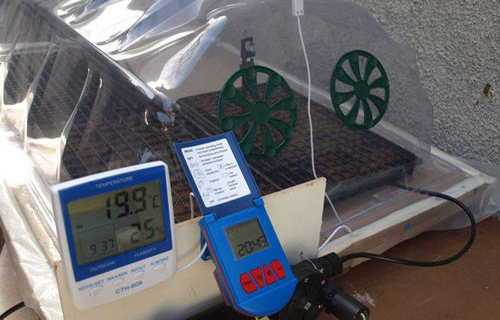
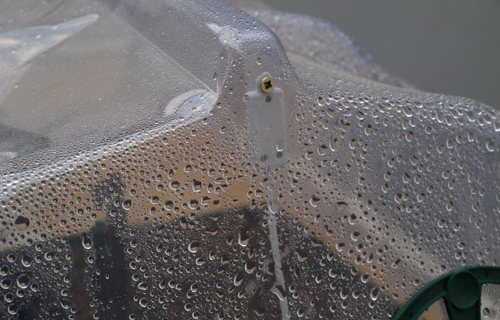
Filter, controller, and thermometer. I want to draw your attention to the fact that this device can be used not only for growing seedlings but also for the green propagation of plants. So you can use it many times throughout the season!
Modernization
Since progress does not stand still, the design has been improved. For more uniform watering and a finer spray, 3 TAV foggers were used. What came of it, you can see the video at the following link:
http://www.youtube.com/watch?v=7QFyeo0N__U&feature=mfu_in_order&list=UL

I think that such a greenhouse will greatly help summer residents and gardeners grow excellent seedlings!